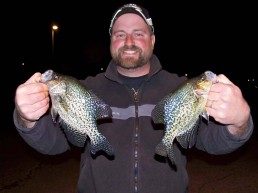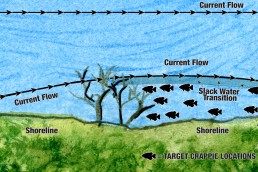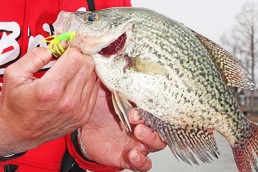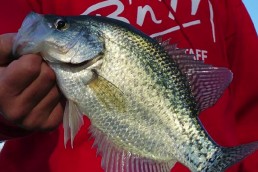The Thunderstorm Crappie Connection
SHARE THIS POST
We all know that weather plays a huge role in the fishing experience. Cold fronts can shut a bite down so fast that you’d think a lake was empty. On the flipside, consistent, warm-weather summer patterns can produce a bounty that the shore angler will never forget.
Although, as a crappie fisherman, one weather phenomenon gets me all worked up: the thunderstorm.
As a land-based fishing guide in Madison, Wis., I first noticed the connection between summer showers and great crappie fishing by accident. Over the years, I’ve turned this pattern into a producer all over the Midwest. From Omaha to Akron, if you’ve got a thunderstorm, you’ve got crappies.
You just have to know where to find them.
Thunder dynamics
When a thunderstorm rolls through, the rain it dumps washes small insects into the water. This is most noticeable where creeks or rivers enter a lake. This is the place to start your search for post-storm crappies. Why? The small insects attract the forage species in the lake. These could be shiners, chubs, shad or any type of small fish. These congregations of bait attract the schools of crappies; that’s what makes thunderstorms so special for the shore-bound angler.
So now that we know the crappies will be present by the creek and river mouths, all we have to do now is catch them.
My favorite technique for thunderstorm crappies is lure fishing under a float. I know it sounds crazy, but this is a deadly technique. The concept is simple: Just put your favorite lure under a float and cast it out into the water. The reason it works so well is because the float allows you to precisely control your lure’s running depth. Take a minute to think about it and it will make perfect sense. Crappies are suspended in the water column, so depending on your lure’s running depth, you will spend most of your retrieve out of the strike zone.
Are you enjoying this post?
You can be among the first to get the latest info on where to go, what to use and how to use it!
Using a float limits how deep the lure can run, so your lure spends all of its time at the ideal running depth. If you need the lure to run higher or deeper in water column, just adjust the float. Once you get hooked up, you’ll know what depth the crappies are feeding. Now, every cast you make is at the perfect depth and you can recreate the presentation, resulting in more caught fish.
Gearing up
Rod selection and rigging is up to you, but I’ll give you a quick glimpse at my favorite setup. I use a medium-weight, spinning rod paired with a 2500 size reel. Normally I spool the reel up with 8-pound-test fluorocarbon. Monofilament line will work, but I prefer fluorocarbon line because it sinks and has the same refractive rate as water. This means that the line pretty much disappears in water so the fish can’t see it. For floats, again, any will do, but I prefer slip bobbers because they can be easily adjusted.
Your lure choice is what really makes a difference when targeting post-storm crappies. Remember that the crappies have come into the creek mouths to go after the baitfish that are eating insects. This means that small minnow imitations are going to be your strongest producers. I use a variety of spoons, crankbaits and scented soft plastics, but my favorite is the Echotail. The Echotail combines the vibration of spoons with the attraction of soft plastics and has been my go-to crappie lure for years.
Using this technique can be a game-changer for the shore angler; it even works well from a kayak or boat. So the next time a summer storm pops on your radar and you’re not directly in its approaching path, don’t let yourself feel down. Get your rods rigged up and head to the lake for some thunderstorm crappies.
Israel Dunn offers human-powered urban fishing adventures by shore or kayak in the Madison, Wis. area. Book a trip with him at shoreboundhero.com and listen to his podcast, “Bluegills to Bull Sharks,” at his website or on iTunes.
MWO
SHARE THIS POST
Did you enjoy this post?
You can be among the first to get the latest info on where to go, what to use and how to use it!
Israel Dunn
Israel Dunn offers human-powered Urban Fishing Adventures by shore or kayak in the Madison, Wis. area. Book a trip with him at shoreboundhero.com and listen to his podcast, “Bluegills to Bull Sharks,” at his website or on iTunes.



